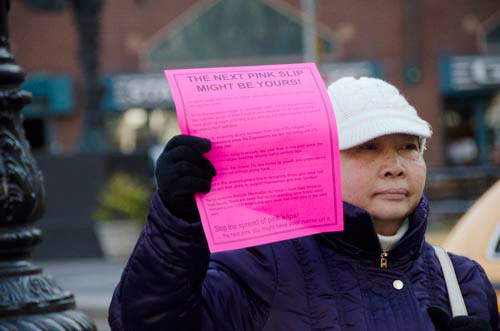
March For Jobs, Peace & Freedom. Washington D.C., August 1983 © Margaret McCarthy
Portfolio reviews are earnest affairs, I've heard them called "stuffy," so it's notable when one finishes one's 10 minutes of speed dating with tears of laughter rolling down one's cheeks which is how it was when I met Margaret McCarthy for the first time and she showed me 'Late Night Animals' - yes, photographs of animals that featured as guests on various late night talk shows. Margaret went on to have a show of the series in New York.
However, it seems as good a time as any for some photographs of protests. As an aside, I hit the streets for my first protest at age 14 under Margaret Thatcher - Meryl Streep won best actress in the Oscars last night for portraying her in a film I wouldn't see even if you promised to keep me in milk for the rest of my life.
So, my alternative title for this story is 'Plus ça change, plus c'est la même chose.'
"The 1980's and 1990's are often portrayed as decades of greed and apathy when social activism vanished. In fact, those times spawned vigorous and committed opposition to a rapidly escalating nuclear arms race and U.S. activities in Central America. A military draft threatened to unfairly target black and inner city youth. Frustration over the treatment of women and same sex couples reached a slow boil as the AIDS crisis hit and abortion rights were continually attacked. We realized the environment was in trouble. A sea change occurred then: the awareness of how all these issues were connected. The cost of war could no longer be separated from issues of racism and poverty; the status of women reflected our relationship to the earth. March events then tended to be multi-issued, asking people to rally around a united consciousness; they cut across lines of race, sex, gender preference, economic status and age.
Color slide film, with its saturated hues, captured the visual richness and drama of these events, as well as the humor and irreverence of their participants. These events were truly 'living theatre' with a message - protest as a creative act. It was important to me to witness and document this pageant of American history not often discussed or acknowledged. Occupy Wall Street was preceded by large-scale demonstrations in opposition to the Iraq War; those were historically connected to the activism of the 1980's and 90's. The anti-war movement of the '60's eventually evolved into a peace movement, which birthed a consciousness of how all the important issues we face are related.
Today a new generation of young activists infuses fresh energy into the peace and social justice movements. I continue to document this multi-cultural, multi-generational activism, hoping to capture its wit, vision, its creative spirit and its fresh sense of urgency.
So what's really changed? (Other than my using digital cameras now?) Look at the jubilant faces of the newly married same sex couples in front of city hall. Look at the in-your-face signs of the young women marching to protect not just abortion rights now, but birth control. Look at the signs from Zuccottti Park; the human mic asks: What is our highest and best future?" - Margaret McCarthy, February, 2012
Continuing her work photographing protests, Margaret hit the streets for 'The Line' march today. "5,000 citizens formed a 3 mile line on Broadway, from the Bull at Bowling Green to Union Square and held up pink slips from 8:14 am to 8:28 a.m. today on Super Tuesday, March 6, 2012. It was a protest to represent 14 million Unemployed Americans & demand action from congress & corporations."

